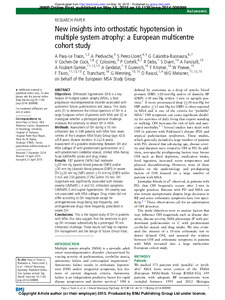Por favor, use este identificador para citar o enlazar este ítem:
https://repositorio.uca.edu.ar/handle/123456789/14266| Título: | New insights into orthostatic hypotension in multiple system atrophy : a European multicentre cohort study | Autor: | Pavy-Le Traon, A. Piedvache, A. Pérez Lloret, Santiago Calandra-Buonaura, G. Cochen De Cock, Valérie Colosimo, C. Cortelli, P. Debs, R. Duerr, S. Fanciulli, A. Foubert Samier, Alexandra Gerdelat, A. Gurevich, T. Krismer, F. Poewe, W. Tison, F. Tranchant, C. Wenning, G. Rascol, O. Meissner, W. G. |
Palabras clave: | COMORBILIDAD; TRASTORNOS DEL MOVIMIENTO; ATROFIA MULTISISTÉMICA; HIPOTENSION ORTOSTATICA | Fecha de publicación: | 2016 | Editorial: | BMJ Publishing Group | Cita: | Pavy-Le Traon, A., et al. New insights into orthostatic hypotension in multiple system atrophy : a European multicentre cohort study [en líena]. Journal of Neurology, Neurosurgery and Psychiatry. 2016, 87(5) doi:10.1136/jnnp-2014-309999 Disponible en: https://repositorio.uca.edu.ar/handle/123456789/14266 | Resumen: | Abstract: Objectives Orthostatic hypotension (OH) is a key feature of multiple system atrophy (MSA), a fatal progressive neurodegenerative disorder associated with autonomic failure, parkinsonism and ataxia. This study aims (1) to determine the clinical spectrum of OH in a large European cohort of patients with MSA and (2) to investigate whether a prolonged postural challenge increases the sensitivity to detect OH in MSA. Methods: Assessment of OH during a 10 min orthostatic test in 349 patients with MSA from seven centres of the European MSA-Study Group (age: 63.6±8.8 years; disease duration: 4.2±2.6 years). Assessment of a possible relationship between OH and MSA subtype (P with predominant parkinsonism or C with predominant cerebellar ataxia), Unified MSA Rating Scale (UMSARS) scores and drug intake. Results: 187 patients (54%) had moderate (>20 mm Hg (systolic blood pressure (SBP)) and/or >10 mm Hg (diastolic blood pressure (DBP)) or severe OH (>30 mm Hg (SBP) and/or >15 mm Hg (DBP)) within 3 min and 250 patients (72%) within 10 min. OH magnitude was significantly associated with disease severity (UMSARS I, II and IV), orthostatic symptoms (UMSARS I) and supine hypertension. OH severity was not associated with MSA subtype. Drug intake did not differ according to OH magnitude except for antihypertensive drugs being less frequently, and antihypotensive drugs more frequently, prescribed in severe OH. Conclusions: This is the largest study of OH in patients with MSA. Our data suggest that the sensitivity to pick up OH increases substantially by a prolonged 10 min orthostatic challenge. These results will help to improve OH management and the design of future clinical trials. | URI: | https://repositorio.uca.edu.ar/handle/123456789/14266 | ISSN: | 0022-3050 1468-330X (online) |
Disciplina: | MEDICINA | DOI: | 10.1136/jnnp-2014-309999 | Derechos: | info:eu-repo/semantics/closedAccess | Fuente: | Journal of Neurology, Neurosurgery and Psychiatry. 2016, 87(5) |
| Aparece en las colecciones: | Artículos |
Ficheros en este ítem:
| Fichero | Descripción | Tamaño | Formato | Login |
|---|---|---|---|---|
| new-insights-into.pdf | 218,58 kB | Adobe PDF | SOLICITAR ACCESO | |
| thumb.pdf | 98,27 kB | Adobe PDF |  Visualizar/Abrir |
Visualizaciones de página(s)
60
comprobado en 27-abr-2024
Descarga(s)
19
comprobado en 27-abr-2024
Google ScholarTM
Ver en Google Scholar
Altmetric
Altmetric
Este ítem está sujeto a una Licencia Creative Commons

